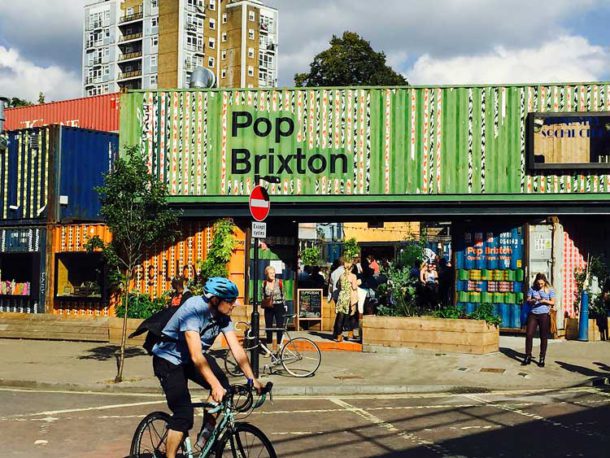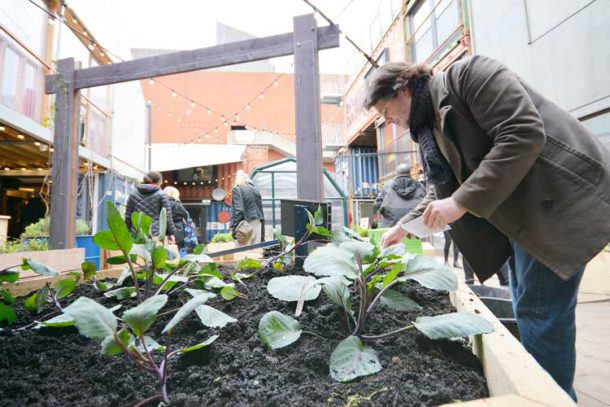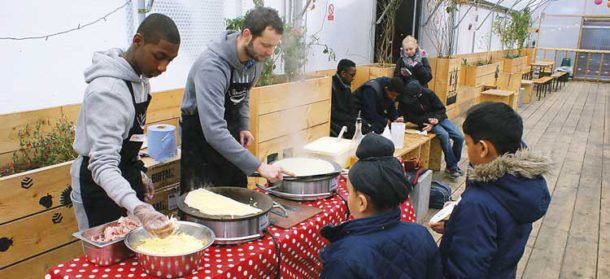It has transformed unused land into a vibrant community, yet Pop Brixton remains a controversial subject. In the month of its first birthday, we ask if it is an inclusive social enterprise, an unwelcome symbol of Brixton’s gentrification, or, perhaps, a bit of both?

The numbers are impressive. In its first year, Pop Brixton – on the site of the old Pope’s Road car park –welcomed more than 750,000 visitors, helped 55 small businesses thrive and created over 200 jobs.
For our readers who have not visited, it lives on a 14,000 square metre council-owned “meanwhile” site. It houses small businesses and start-ups in shipping containers and provides space for training, events and community projects. Without real precedent (no, it’s not BOXPARK Shoreditch mark II) Pop Brixton is an ambitious experiment; a venture into the unknown.
Leading the charge is Make Shift – the organisation that chooses which small businesses will call the site “home”. With birthday preparations in full swing, commercial and community director Philippe Castaing and managing director James Leay took time out to speak to the Blog.
Meeting the pair is like uncovering the Wizard(s) of Oz. They work out of the shipping container behind the main Pop Brixton site; the men behind the curtain. Only in this modern adaptation the curtain is made of steel and they share office space with young trendies on iMacs.
We head to the “greenhouse” and Castaing (who first featured on the Blog nearly six years ago) is keen to talk about the scope of the project. Pre-empting a frequent criticism, he says: “The food and drink space in Pop Brixton is less than 35% of our footprint. When we opened last year, the ground and first floors were predominantly made up of retail and food and drink businesses – the perception has stuck.
“The only reason we set up was to deliver social change,” says Castaing. Pop Brixton does have a social conscience and to be considered for a lease at the site businesses must pledge one hour a week to the “community investment” scheme. This is overseen by the Brixton Pound. Its role is twofold: to broker and create new opportunities for traders at Pop to get involved with community and social related activities; and to monitor overall activity of this nature to ensure it is on track and that traders are fulfilling their pledge.
Under the stewardship of the Pound, the community investment scheme has manifested itself in school visits, apprenticeships, work experience placements, free bursaries for training courses, free meals and free cooking classes for children. To date, the Pound has logged over 1,000 hours of such activity.
It has given a platform to 20 startups, 27 small- or medium-sized enterprises and six social enterprises.
Many businesses have received help to develop their business plan and 14 apprenticeships, 20 work experience opportunities and six traineeships have been created.

Pop Brixton has set up a community garden (Pop Farm) which grows herbs and vegetables for use by local people; offered education and training and free gardening workshops; and hosted a youth enterprise day and a mental health seminar. It provides free training and events space and, in short, has endeavoured to become part of the community.
Councillor Jack Hopkins, Lambeth council’s cabinet member for regeneration, business and culture, has described Pop’s business model as “enlightened self-interest”.
It is business that inspires Castaing’s vision for an inclusive Brixton: “We need to make money or else we can’t deliver social change and support local people. That’s why our drive is business and we will be as hard as we need to be to deliver that.”
When asked for his highlights of the past year, Castaing recalls receiving letters from schoolchildren, thanking him for a recent tour of the site. He tells me he had tears in his eyes and that, addressing his equally emotional team, said: “Well you know guys, that’s why we get up in the morning.”
But the background to his recollection was the thumping electronic music that had been playing for the past ten minutes. This was the Pop Brixton Time Out raved about. The one readers voted runner-up in the culture category of the publication’s 2015 Love London awards. It is hard to square it with school trips.
But then there is a lot about Pop Brixton that isn’t entirely clear – like what locals make of it, for example.
During our conversation Castaing and Leay make reference to a number of fans. Of local convenience store, Ashok’s, Castaing says: “They love us!” And they do. Ashok himself, now 64, opened the shop 40 years ago and, speaking to me from behind the till, says: “It has been very good for us. More people are coming here and trade has gone up. It’s changed the area a lot. More business people are coming in and more people from across London. It’s brightening up Brixton!”
Tim, who has been running a fruit and veg stall in Brixton Market since he was 16 (he’s now 36), is similarly positive. “At the end of the day I think it helps the local area having a lot of restaurants. I think it’s brought a bit of a different crowd to the market to be fair, but I’ve been getting a bit of business off some of them [Pop Brixton traders] as well because they come here and buy the berries and what not for their juices.”

Such positivity is not universally shared. John Gordon, 62, the operations director of the Brixton Market Traders’ Federation and a market trader for more than 35 years, sounds a rather different note.
“Pop Brixton appeals to retail tourists who visit maybe only once and just see it as a tourist attraction, not a community hub. To them it’s just another retail facility … it’s just a place to eat and drink and then to move on. They have no desire to be part of the community.
“We were consulted, yes, in the council’s definition of consultation. They hear what they want so they can tick the ‘consulted’ box and then just carry on implementing their own view of what should happen.
“Pop Brixton is a perfect example of what happens when developments take place without meaningful engagement with the local community.”
Damning, yes, but no more so than the views of The Edible Bus Stop (EBS).
To contextualise their stance requires a history lesson. Pop Brixton came to take its current form following a council-run competition. The brainchild of Tom Bridgman, delivery lead within the regeneration team of Lambeth council, the chosen project would, according to the original brief, “support local groups, complement, not compete with, local businesses and keep money and skills locally”.
This was itself part of Lambeth council’s Orwellian-sounding Brixton Central masterplan, part, in turn, of the Future Brixton project.
At this stage, Pop Brixton wasn’t “Pop Brixton” at all, but “Grow:Brixton”, and it was in answering this brief that, together with Carl Turner Architects, The Edible Bus Stop were successful.
However, no sooner had they been named winners than a rift developed between Turner and EBS, resulting in the latter leaving the project. Moving forward, the renamed Pop Brixton would be overseen by Carl Turner Architects and Make Shift.
Time has not proved the greatest healer. A spokesperson for EBS said: “We’d like to publicly state we did not ‘opt out’ of the Pope’s Road meanwhile site. We were given no choice by our former partner Carl Turner.
“What has been delivered is a much denser scheme, with limited public space. It’s become a mono-cultural destination, an 18-30 club and it certainly isn’t providing any significant cultural offering to Brixton.
“What Pop has done is use community as a commodity to promote an underlying commercial agenda.”
Falling somewhere between staunch critic and super fan is Somora Rattray, the boss of Flower Love London flower stall in Brixton market, the closest market stall to Pop Brixton, some ten yards away.
Before Pop opened she was offered a unit on site. She declined, but has not cut ties and still provides flowers for a number of their events. “I like being inclusive and not everyone goes into Pop Brixton so I decided to stay out here,” she told me.
“I don’t think they mean to exclude people. But I’m a Lambeth resident and I’ve lived here all my life and there are a lot of customers I have, especially the more elderly West Indian community, that don’t feel that’s for them.
“It is a double edged sword. I hate the gentrification and I hate that it’s forcing people and businesses out of Brixton that have been here a long time.
“But then, on the flip side of that, I run a flower business and flowers are a luxury item. So it’s that more affluent customer who’s going to spend their money with me.”
Many stories have come from Pop Brixton’s first year, but perhaps the most intriguing come from its traders. Together they run the site’s huge array of businesses.
There’s Zoe’s Ghana Kitchen and Mama’s Jerk, a New Zealand wine cellar and Donostia Social Club – a street food van and an events/catering company. There’s Afro Retro – an ethical British-Ugandan fashion and lifestyle brand, a vinyl music shop and a barbers.
Impact Hub Brixton is a membership community for people working on projects for a better Lambeth and beyond.
Bounce Back is a training charity and a painting and decorating social enterprise focused on supporting ex-offenders into work. Then there’s Reprezent Radio, run by and for young people.
Julianna Barnaby of Barnaby & Co is a tax lawyer-turned-entrepreneur. She was in the process of quitting her job in the City and starting up her own business when Pop Brixton was finding its feet.
Two pop-up stalls later, one in October and one for the whole of December and she was in talks over a permanent shop – something she opened in February earlier this year.
Given her seismic career change, Julianna is well qualified for her giveback scheme: hosting entrepreneur workshops in schools to show children that there are alternatives to conventional careers.
Barnaby & Co stocks quirky homewares and gifts. Julianna is a keen photographer and all the photographs available for purchase in the shop are her own handiwork.
“I liked what Pop Brixton was about,” she says. And what’s that? “Pop Brixton is about encouraging start-ups and young companies. Encouraging entrepreneurship and providing people with a place where they can talk with other start-ups and trade next to other food businesses or retailers who are in a similar position.
“It’s also about showing the community that just because Brixton is changing doesn’t necessarily mean it has to be a negative thing.
“Brixton from 10 years ago is very different to how it is now but, actually, some of those changes are really positive. When you’ve got small companies and entrepreneurs coming into Brixton, or who are from Brixton, that can be a really positive thing.”

The entrepreneurial spirit exemplified by Julianna and others at Pop Brixton, perhaps more than any other factor, is what is responsible for the project’s success. And, in its own terms, it has been a huge success.
In his blog, Councillor Hopkins says: “Pop Brixton feels like it’s been around for longer than a year. It feels part of Brixton. And being of Brixton was always something which guided us … Pop’s not perfect, but it’s a damn mighty effort at walking the walk on opportunity and the benefits of regeneration for those of our number who need it.”
Matt Parr, a ward councillor for Coldharbour (in which Pop Brixton sits), is equally enthusiastic: “I find it a bit depressing that an initiative as innovative as Pop is denigrated … all in all, Pop Brixton is an exciting scheme led by Lambeth council which has made Brixton an even more desirable place to live, given work opportunities to hundreds of people and tested out lots of ideas for supporting entrepreneurs.”
According to the Local Government Association’s 2016 Lambeth State of the Borough report, “Coldharbour is the most deprived ward by some way”. More than half of its lower super output areas (SPOA) – small areas used by government statisticians – are in the 10% most nationally deprived.
It is among the most deprived wards in Lambeth for income deprivation; barriers to housing and services; income deprivation affecting children; and income deprivation affecting older people.
Beyond the numbers, the daily realities of living in the ward are experienced in vastly different ways. In Angell Town, for instance, 12 minutes’ walk from Pop Brixton according to Google Maps, there were two shootings in the month of May alone.
Parr concedes: “I do understand those who say that there is an issue about how representative of the community the clientele of Pop is.”
To some, Pop Brixton is a symbol of the area’s gentrification. It is more expensive than its neighbouring market and only appeals to a certain “type”.
Aurora Estany is co-founder of Viet box at Pop Brixton – a Vietnamese restaurant she runs with her brother, Raphael. She has lived in Brixton for the past decade and says: “London is changing a lot. People complain about gentrification, but change is good. I buy most of my products from Brixton market. It’s unfair to say there’s been too much gentrification because a lot of people who say that were part of the first wave of gentrification in the area.
“Some people don’t feel they are welcome in Pop Brixton. I get it because Pop Brixton is young, but they are more than welcome. I think it was the same when the Village opened, but now it’s really a part of Brixton. I hope Pop is the same.”
Castaing puts it in more stark terms: “There’s always that argument: you know, in the old days … Go and speak to the flower guys outside the station and ask them how it was 20 years ago.
“They’ll tell you it was a shit hole and they couldn’t sell flowers because people were knifed in the street. That’s not a pleasant place.
“It’s a very complex debate … poor areas need investment. The issue is how you capture that investment so it benefits local people.”
Change is not inherently bad. According to the 2016 Lambeth State of the Borough report, 53% of Lambeth residents say their neighbourhood is changing for the better and 45% say their local area is a better place to live than two years ago, compared to 13% who say it is worse.
The report also says that at least 318,000 people live in Lambeth. If this figure is accurate, it would mean that Pop Brixton has seen the equivalent of every member of Lambeth visiting … twice.
Nor, of course, is gentrification an exclusively Brixton issue. As The Economist poetically puts it: “The frontier of where you can buy a cocktail in a jam jar is moving like German tanks through the Ardennes: from Shoreditch to Dalston; Brixton to Peckham; Bethnal Green to Hackney Wick.”
Quantifying what Pop Brixton has meant for the local community is difficult. While the site does not pay rent (one of the perks of winning the competition) all profits from the enterprise are shared with Lambeth council 50:50. What these profits look like is unknown.
The council’s futurebrixton.org website says: “In the interest of transparency, Pop Brixton is committed to publishing its own finances and will do so by the end of February 2016.” The link is no longer active, but what it did look like can be viewed here. With no report forthcoming, an FOI request to Lambeth council in March by Brixton Buzz’s Jason Cobb asked where they had been published. The response was: “We have made contact with Pop Brixton and they advise that the audited accounts should be available by the end of April 2016 and will be made available on their website.”
Now, in June, the financial information is still nowhere to be seen. The latest: It is said they will be published at the end of August.
There are other issues, like a controversy over how much Pop Brixton Community members pay for their stalls. But on the face of it at least, Pop Brixton continues to flourish.
Last weekend it opened Pop Fields – a temporary hub for sporting activity and entertainment over the summer months next to the current Pop site.
For Make Shift, Pop Brixton is just the beginning and now they are looking ahead to a new project: Peckham Levels. Due to open in the autumn, Castaing says it will “transform seven inner levels of a multi-story car park in Peckham into a creative community for local people, artists and entrepreneurs”. Sound familiar?
Meanwhile, back on our own turf, what does the future hold for Pop Brixton? Well, the original lease is until October 2017, but Leay says: “I think we can safely say October 2018, we’re pretty confident we’re going to get at least until October 2018.
“I hope it will be like the Eiffel tower y’ know, built for a year, there for 100.”
Near the end of our conversation Leay says: “The whole point of the scheme was to inform what happens afterwards. I’m sure there will be a big tower block of flats built here one day.
“But can there be a really interesting market hall with small businesses in it? Can we include in it a big co-working space? Can we get small businesses built into that next phase of development?”
Continued regeneration in Brixton is inevitable; influencing what direction this takes is perhaps the best that can be hoped for.
As for Pop Brixton, given the success of its first year, it would be no surprise if it was here to stay for some time.














[…] the words of Harry Yeates (Brixton Blog), Pop is controversial, a grey area which sits somewhere between being “an inclusive social […]